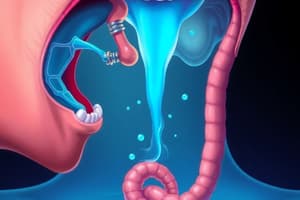Podcast
Questions and Answers
What condition could result from a large volume of food or liquid being aspirated?
What condition could result from a large volume of food or liquid being aspirated?
- Dry mouth
- Gastric reflux
- Inflammation of the throat
- Pneumonia (correct)
What psychological effect can dysphagia have on an individual during mealtimes?
What psychological effect can dysphagia have on an individual during mealtimes?
- Improved self-esteem
- Enhanced social interaction
- Increased appetite
- Fear of choking (correct)
What dental issue may be exacerbated by the difficulties associated with dysphagia?
What dental issue may be exacerbated by the difficulties associated with dysphagia?
- Teeth whitening
- Canker sores
- Gingivitis
- Increased tartar buildup (correct)
How can malnutrition arise from dysphagia?
How can malnutrition arise from dysphagia?
What is a common symptom associated with acid reflux due to dysphagia?
What is a common symptom associated with acid reflux due to dysphagia?
What is the primary purpose of mastication in the digestive process?
What is the primary purpose of mastication in the digestive process?
Which structures are primarily involved in the process of mastication?
Which structures are primarily involved in the process of mastication?
Which phase of the masticatory cycle involves the closing of the mouth to chew food?
Which phase of the masticatory cycle involves the closing of the mouth to chew food?
Which enzyme in saliva begins the digestive process?
Which enzyme in saliva begins the digestive process?
What disorder can significantly affect the normal process of deglutition?
What disorder can significantly affect the normal process of deglutition?
What consideration should be taken in the dental management of patients with dysphagia?
What consideration should be taken in the dental management of patients with dysphagia?
What is the impact on a patient's ability to eat if they are limited by muscle function during mastication?
What is the impact on a patient's ability to eat if they are limited by muscle function during mastication?
What is the primary role of saliva in the process of swallowing?
What is the primary role of saliva in the process of swallowing?
How long does it typically take for the bolus to travel from the oral cavity to the stomach?
How long does it typically take for the bolus to travel from the oral cavity to the stomach?
Which of the following is a possible sign of dysphagia?
Which of the following is a possible sign of dysphagia?
Which structures are involved in closing the openings during swallowing?
Which structures are involved in closing the openings during swallowing?
What initiates the swallowing reflex?
What initiates the swallowing reflex?
Which condition is NOT typically associated with causing dysphagia?
Which condition is NOT typically associated with causing dysphagia?
Which nerves are primarily involved in transmitting impulses to the swallow center?
Which nerves are primarily involved in transmitting impulses to the swallow center?
What might occur if there is a delay in the swallow reflex?
What might occur if there is a delay in the swallow reflex?
How many skeletal muscles are involved in the swallowing process?
How many skeletal muscles are involved in the swallowing process?
Which of the following can contribute to age-related dysphagia?
Which of the following can contribute to age-related dysphagia?
What is the risk associated with poorly positioning a patient during or after eating?
What is the risk associated with poorly positioning a patient during or after eating?
What types of swallowing are recognized?
What types of swallowing are recognized?
What is the function of the swallow center located in the brainstem?
What is the function of the swallow center located in the brainstem?
Which of the following describes 'refluxed' material during swallowing?
Which of the following describes 'refluxed' material during swallowing?
What can reduced pharyngeal peristalsis lead to?
What can reduced pharyngeal peristalsis lead to?
Which component does the arousal of appetite stimulate during swallowing?
Which component does the arousal of appetite stimulate during swallowing?
Which of the following conditions is related to muscle weakness affecting swallowing?
Which of the following conditions is related to muscle weakness affecting swallowing?
Which of these statements about chewing food properly is correct?
Which of these statements about chewing food properly is correct?
What might cause swelling of the mucosa in the throat?
What might cause swelling of the mucosa in the throat?
What role do the lips play in the swallowing process?
What role do the lips play in the swallowing process?
What structure rises to block off the nasopharynx during swallowing?
What structure rises to block off the nasopharynx during swallowing?
During swallowing, what is the primary function of the hyoid bone?
During swallowing, what is the primary function of the hyoid bone?
Which phase of swallowing is initiated voluntarily?
Which phase of swallowing is initiated voluntarily?
What happens to the vocal cords during the swallowing process?
What happens to the vocal cords during the swallowing process?
Which structure relaxes to allow food to enter the oesophagus?
Which structure relaxes to allow food to enter the oesophagus?
In which phase does the actual propulsion of the bolus occur after the oral phase?
In which phase does the actual propulsion of the bolus occur after the oral phase?
Which structure is primarily responsible for forming the bolus of food?
Which structure is primarily responsible for forming the bolus of food?
What occurs to the epiglottis during swallowing?
What occurs to the epiglottis during swallowing?
Which structure supports the tongue and is associated with the muscles during swallowing?
Which structure supports the tongue and is associated with the muscles during swallowing?
Flashcards
Mastication
Mastication
The process of chewing food.
Deglutition
Deglutition
The process of swallowing food.
Dysphagia
Dysphagia
Difficulty swallowing.
Masticatory cycle
Masticatory cycle
Signup and view all the flashcards
Muscles of mastication
Muscles of mastication
Signup and view all the flashcards
Saliva
Saliva
Signup and view all the flashcards
Impact of Limited Oral Structures on Eating
Impact of Limited Oral Structures on Eating
Signup and view all the flashcards
Bolus Formation
Bolus Formation
Signup and view all the flashcards
Swallowing Time
Swallowing Time
Signup and view all the flashcards
Swallowing Pathway Closure
Swallowing Pathway Closure
Signup and view all the flashcards
Automatic Swallow
Automatic Swallow
Signup and view all the flashcards
Voluntary Swallow
Voluntary Swallow
Signup and view all the flashcards
Swallowing Center
Swallowing Center
Signup and view all the flashcards
Swallowing Reflex Trigger
Swallowing Reflex Trigger
Signup and view all the flashcards
Swallowing Muscles
Swallowing Muscles
Signup and view all the flashcards
Swallowing Phases
Swallowing Phases
Signup and view all the flashcards
Oral Phase
Oral Phase
Signup and view all the flashcards
Pharyngeal Phase
Pharyngeal Phase
Signup and view all the flashcards
Esophageal Phase
Esophageal Phase
Signup and view all the flashcards
Lips
Lips
Signup and view all the flashcards
Tongue
Tongue
Signup and view all the flashcards
Soft Palate
Soft Palate
Signup and view all the flashcards
Hyoid Bone
Hyoid Bone
Signup and view all the flashcards
Epiglottis
Epiglottis
Signup and view all the flashcards
Vocal Cords
Vocal Cords
Signup and view all the flashcards
Causes of Aspiration
Causes of Aspiration
Signup and view all the flashcards
Dehydration and Dysphagia
Dehydration and Dysphagia
Signup and view all the flashcards
Malnutrition and Dysphagia
Malnutrition and Dysphagia
Signup and view all the flashcards
Dental Issues from Dysphagia
Dental Issues from Dysphagia
Signup and view all the flashcards
Dysphagia Causes
Dysphagia Causes
Signup and view all the flashcards
Dysphagia Symptoms
Dysphagia Symptoms
Signup and view all the flashcards
Neurological Dysphagia Causes
Neurological Dysphagia Causes
Signup and view all the flashcards
Structural Dysphagia Causes
Structural Dysphagia Causes
Signup and view all the flashcards
Pharyngeal Stage Delay
Pharyngeal Stage Delay
Signup and view all the flashcards
Reduced Pharyngeal Peristalsis
Reduced Pharyngeal Peristalsis
Signup and view all the flashcards
Oesophageal Stage Issue
Oesophageal Stage Issue
Signup and view all the flashcards
Aspiration Risk
Aspiration Risk
Signup and view all the flashcards
Poor Positioning and Aspiration
Poor Positioning and Aspiration
Signup and view all the flashcards
Other Dysphagia Causes
Other Dysphagia Causes
Signup and view all the flashcards
Study Notes
Mastication, Deglutition & Dysphagia
- This presentation covers the processes of chewing (mastication) and swallowing (deglutition), both in healthy and diseased states
- Learning objectives include describing relevant anatomy and physiology, outlining structures involved, identifying related disorders, and understanding dental management of dysphagia patients.
- Key related topics include muscles of mastication, tongue, saliva/salivation, palate, xerostomia, and regional anatomy.
Intended Learning Outcomes
- Students will be able to describe the processes of mastication and deglutition, including the phases involved.
- Students will be able to identify the structures involved in these processes.
- Students will be able to list disorders affecting normal deglutition.
- Students will be able to outline considerations for dental management of patients with dysphagia.
Mastication
- This lecture segment discusses the act of chewing food.
- Key structures involved in mastication include teeth, tongue, muscles of mastication, and lips.
- Mastication is crucial for breaking down food, initiating digestion, and preparing food for swallowing.
- Loss of function in any of these structures may affect the ability to chew and/or eat.
- The masticatory cycle involves three phases: opening, closing and occlusal.
Deglutition [The Normal Swallow]
- Swallowing, or deglutition, is a complex process.
- The action of swallowing takes about 7 seconds.
- Key structures involved in swallowing: lips, tongue, soft palate, epiglottis, larynx, esophagus, and the pharynx.
- Swallowing involves two types of swallows: automatic/dry and voluntary/food and drink.
- Swallowing is initiated by receptors in the oropharynx, and involves 25 skeletal muscles working together.
Swallowing Structures
- The presentation lists the key structures involved in the swallow process, including details about each structure and its role
- The bolus of food moves through the oral cavity, pharynx, and esophagus via coordinated muscular actions
- Structures that form the pathway for food include the lips, soft palate and tongue
- Other structures such as the larynx, epiglottis, and cricoid cartilage are involved with ensuring food goes down the correct pathway.
Swallowing Occurs in Three Phases
- The swallowing process consists of the oral, pharyngeal, and esophageal phases.
- The oral phase is voluntary and involves the manipulation of food into a bolus.
- The pharyngeal phase is involuntary and moves the bolus into the esophagus.
- The esophageal phase involves involuntary peristaltic waves transporting the bolus to the stomach.
Dysphagia [Swallowing Difficulties]
- Dysphagia is the medical term for having difficulty swallowing.
- Possible signs that a patient may be experiencing dysphagia (swallowing problems) include food going down the wrong way, coughing when eating, feeling food stuck in the throat, dribbling while eating, taking too long to swallow, and/or difficulty chewing food properly.
- The primary cause of dysphagia is often a throat infection or inflammation that produces pain while swallowing.
- Possible causes of dysphagia include stroke, cerebral palsy, Parkinson's, cleft palate, head and neck cancer, dementia, infections, drugs, and age-related changes.
Disorders of the Pharyngeal Stage
- Delayed swallow reflex can allow food to enter the airway before the reflex has been triggered for the swallow
- Reduced pharyngeal peristalsis can result in residue remaining potentially interfering with normal breathing
Disorders of the Esophageal Stage
- Reduced peristalsis in the esophagus can cause food to reflux into the pharynx and potentially lead to aspiration.
Dental Management of Dysphagia
- Reduced oral clearance, increased plaque/calculus deposits, and dry mouth can arise from dysphagia
- Dental considerations for patients with dysphagia include patient assessment (medical history, extent of dysphagia, oral hygiene, diet, altered diet, OH difficulties), patient positioning (comfortable posture), treatment (careful use of water, fast handpieces), and preventative advice (non-foaming toothpastes, avoiding mouthwashes).
Additional Resources
- Helpful resources and links to associated material regarding dysphagia are provided.
- This could include additional information, videos, or articles to aid further study
Studying That Suits You
Use AI to generate personalized quizzes and flashcards to suit your learning preferences.




